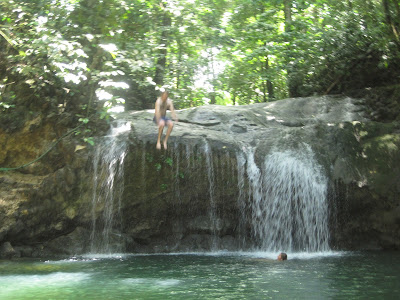5/15-18
After a couple nights at Hotel Kangaroo, we took a “lancha” or small boat about an hour downstream, only about 20 minutes before the river dumps out in the Caribbean. Here, we stayed at “Finca Tatin” where the receptionist was a shirtless German guy named Chris. As Chris showed us the different options for a room, crabs scattered out of our way, parrots appeared in trees, and the general cacophony of the jungle filled our ears. This hotel is made up of a dozen or so thatched-roof bungalows connected by wooden dock-like walkways set deep in the jungle, only accessible by the river. Our room was on the second story of “La Casa Grande” which was simply a large thatched-roof building, entirely open with no walls. The bottom floor held 8 hammocks, and a few sofas. Our bed had a mosquito net draped over it, giving a sense of security, but also inducing sense of fear knowing that the nets were necessary. It was like camping out in the loft of a big treehouse deep in the jungle. Each night, it would rain hard, an incredibly satisfying and soothing sound as we fell asleep.
After a couple nights at Hotel Kangaroo, we took a “lancha” or small boat about an hour downstream, only about 20 minutes before the river dumps out in the Caribbean. Here, we stayed at “Finca Tatin” where the receptionist was a shirtless German guy named Chris. As Chris showed us the different options for a room, crabs scattered out of our way, parrots appeared in trees, and the general cacophony of the jungle filled our ears. This hotel is made up of a dozen or so thatched-roof bungalows connected by wooden dock-like walkways set deep in the jungle, only accessible by the river. Our room was on the second story of “La Casa Grande” which was simply a large thatched-roof building, entirely open with no walls. The bottom floor held 8 hammocks, and a few sofas. Our bed had a mosquito net draped over it, giving a sense of security, but also inducing sense of fear knowing that the nets were necessary. It was like camping out in the loft of a big treehouse deep in the jungle. Each night, it would rain hard, an incredibly satisfying and soothing sound as we fell asleep.
Here is La Casa Grande. We slept upstairs in the beds covered with mosquito nets.
Again, we went kayaking, this time for 4 hours up to a
“biotopo” or wildlife reserve area on the river. We brought lunch with us, and
as we were about to head home, it started raining harder than I’ve ever experienced.
For our next two hours home, it rained furiously, requiring us to spend half of
our time bailing water out of the kayak. We were drenched from head to toe
after just 5 minutes. It rained so hard it almost hurt, but it was one of the
more unique experiences we’ve ever had on the water. Plus, it was nice to cool
down a bit in the heat.
At the mouth of the river, a town called Livingston fuses
Guatemalan life with Jamaican-like culture, into what is known as “Garifuna.”
One highlight here was eating Talpado, a well-known, local soup served with a
whole fish, crab, potatoes, bananas, squid, shrimp, and who knows what else in
a delicious orange broth consisting mostly of coconut milk and spices. Not
knowing that the dish could easily feed four people, David ordered a sandwich
to complement what was assumed to be a moderate serving of soup, but when the
bowl came out, we had to get an additional bowl and two additional plates just
to unpack the soup. I’ve never unpacked soup before, but it was definitely
necessary with this Livingston delicacy.
 |
| Where's David? |
Tomorrow, we take two boat trips and a 6 hour bus ride to
get back to Guatemala City before flying out the next morning. We can’t believe
six weeks in Guatemala is nearly over. It’s been like a long honeymoon all over
again!
 |
| Caribbean Coast, as viewed from Livingston |



























